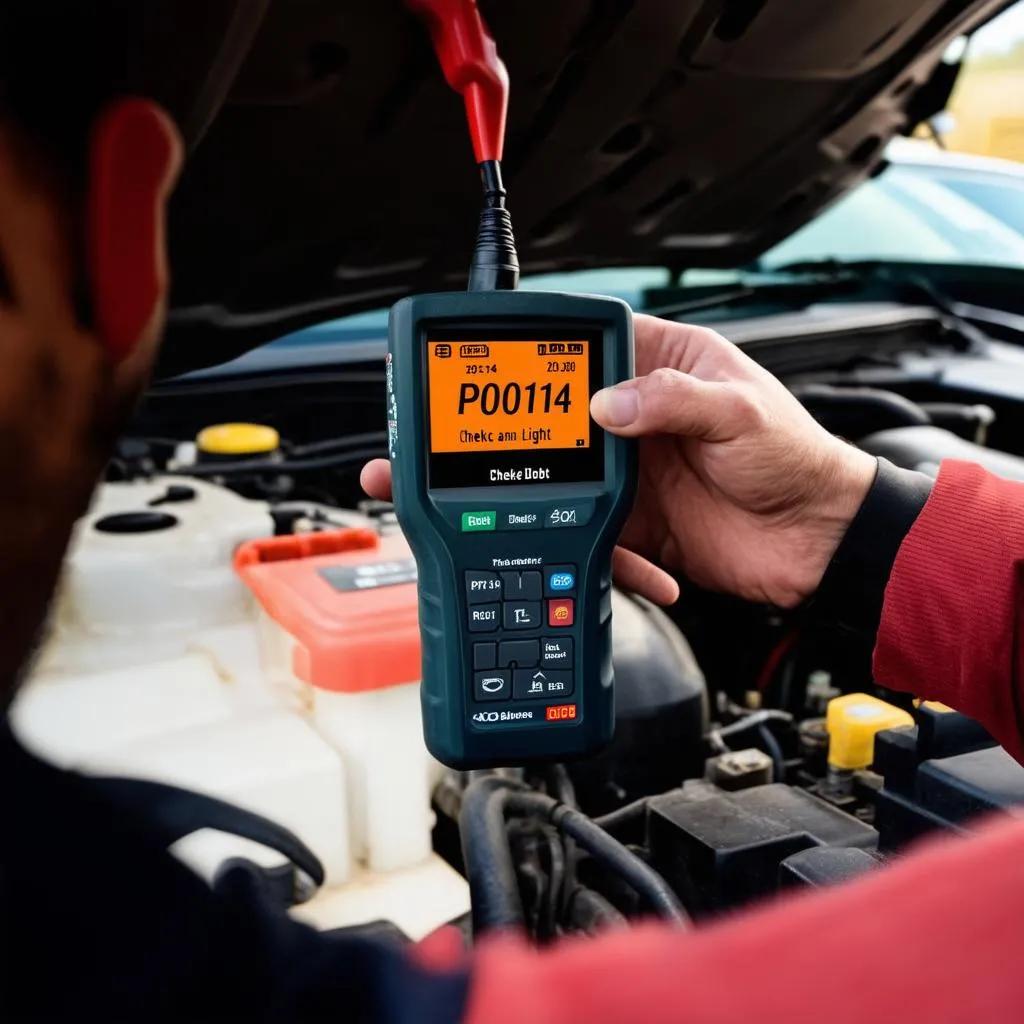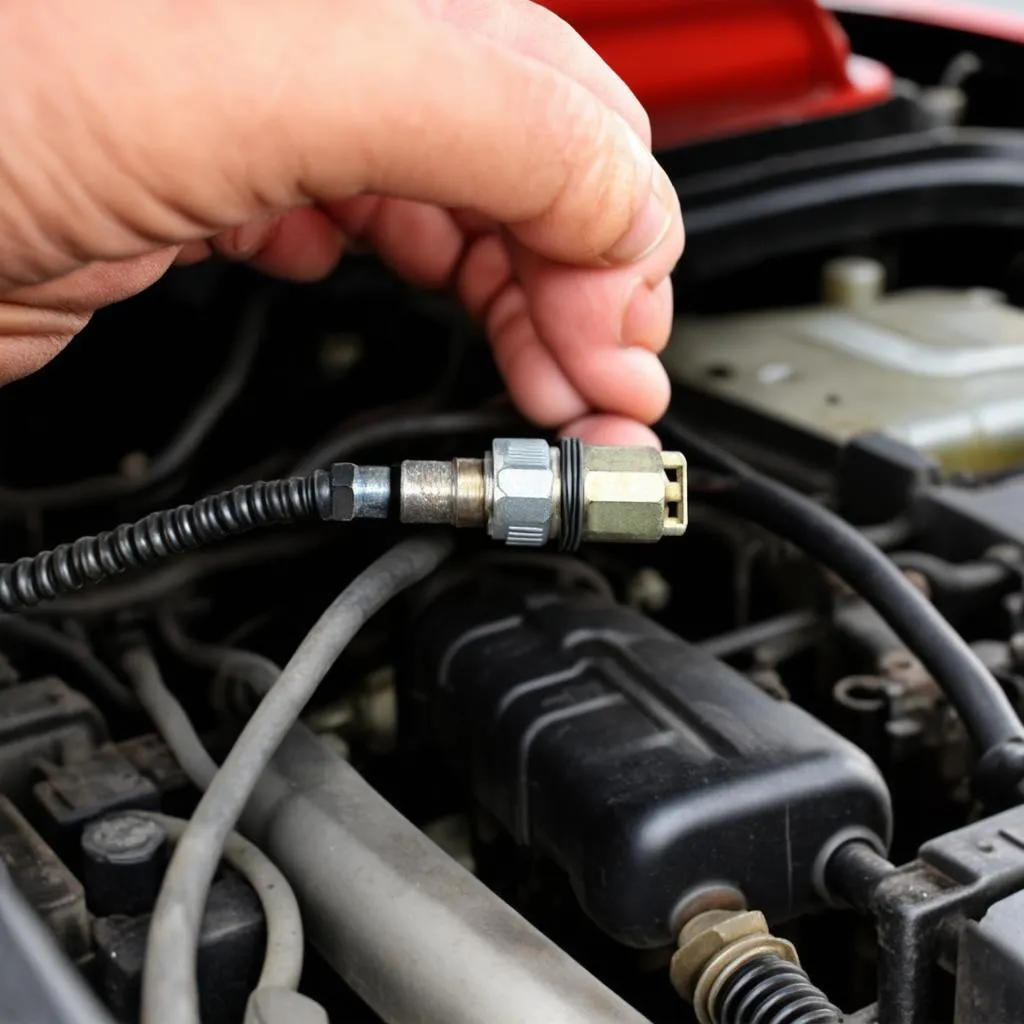“Check engine” light glaring at you again? Don’t panic – it might just be whispering the enigmatic code “P0141”. Sounds like something out of The Matrix, right? Well, it’s actually your car’s way of telling you something’s up with the oxygen sensor. Think of it like your car’s nose, sniffing out the exhaust fumes to make sure everything is running smoothly.
What Does Obd P0141 Mean?
This code specifically points to a problem with the oxygen sensor heater circuit in Bank 1, Sensor 2. Now, what does that even mean? Let’s break it down:
- Bank 1: This refers to the side of the engine that houses cylinder #1.
- Sensor 2: This indicates the downstream oxygen sensor, the one located after the catalytic converter.
- Heater Circuit: The oxygen sensor needs to be warmed up to operate correctly, and that’s where the heater circuit comes in.
So, P0141 basically means the computer in your car (the Engine Control Unit or ECU) has detected a fault in the heater circuit of that specific oxygen sensor.
But why should you care?
Well, imagine trying to bake a cake without preheating the oven. It’s not going to end well, right? Similarly, a malfunctioning oxygen sensor can mess up your car’s engine performance and fuel economy.
Unraveling the P0141 Code: Causes and Symptoms
Just like a detective searching for clues, we need to investigate the possible culprits behind this error code:
Common Causes:
- Faulty oxygen sensor: This is often the prime suspect. Over time, the sensor can become worn out or contaminated.
- Damaged wiring: Frayed, burnt, or disconnected wires in the heater circuit can disrupt the flow of electricity.
- Blown fuse: A blown fuse in the oxygen sensor heater circuit can cut off power completely.
- Faulty ECU: While less common, a problem with the ECU itself can also trigger this code.
Symptoms You Might Experience:
- Illuminated check engine light: The most obvious sign.
- Decreased fuel economy: Your car might start guzzling more gas than usual.
- Rough idling or engine hesitation: You might feel the engine vibrating excessively or struggling to maintain a steady idle.
- Failed emissions test: A malfunctioning oxygen sensor can increase emissions, leading to a failed test.
Conquering the P0141 Beast: Diagnosis and Solutions
Don’t worry, we’ve got you covered! Here’s what you can do to tackle this issue:
Diagnosis:
- Read the code: The first step is to confirm the code using an OBD-II scanner.
- Visual inspection: Check the wiring and connectors around the oxygen sensor for any visible damage.
- Voltage and resistance tests: Use a multimeter to test the voltage and resistance of the heater circuit.
- ECU check: If all else fails, it’s worth having a mechanic check the ECU for any issues.
Solutions:
- Replace the oxygen sensor: If the sensor is faulty, replacement is the most effective solution.
- Repair or replace damaged wiring: Fix any damaged wires or connectors to ensure proper electrical flow.
- Replace the blown fuse: A simple fuse replacement can sometimes solve the problem.
- Consult a professional: If you’re not comfortable with DIY repairs, it’s best to seek professional help.
Remember, timely diagnosis and repair can save you from potential headaches down the road, including costly repairs and damage to other engine components.
Beyond the Technical: P0141 and Your Car’s Karma
While there’s no direct correlation between oxygen sensors and karma, keeping your car in good shape aligns with the principles of balance and harmony. A well-maintained car runs smoothly, consumes fuel efficiently, and minimizes its environmental impact – all positive actions that contribute to a more harmonious existence.
For those who believe in the power of positive energy, consider having your car cleansed or blessed after repairs. While it might not directly fix a faulty sensor, it can bring peace of mind and good vibes to your driving experience.
 Car Mechanic Checking Engine Light
Car Mechanic Checking Engine Light
FAQs: Demystifying the P0141 Code
Q: Can I still drive my car with a P0141 code?
A: While you might be able to drive for a short period, it’s not recommended. Driving with a faulty oxygen sensor can lead to decreased fuel economy, increased emissions, and potentially damage other engine components.
Q: How much does it cost to fix a P0141 code?
A: The cost can vary depending on the root cause and your car’s make and model. A new oxygen sensor can cost anywhere from $50 to $250, while labor costs can range from $50 to $150.
Q: Can a bad catalytic converter cause a P0141 code?
A: While a bad catalytic converter can cause similar symptoms, it usually triggers a different code. However, a faulty oxygen sensor can sometimes be an early indication of a failing catalytic converter.
Q: Can I replace the oxygen sensor myself?
A: If you’re comfortable with basic car repairs, you can find plenty of online resources and tutorials to guide you. However, if you’re unsure, it’s always best to consult a professional.
 Car Oxygen Sensor Replacement
Car Oxygen Sensor Replacement
Explore Further: More Automotive Insights from TechCarUSA
- Learn about other common OBD codes and their meanings: [Link to OBD Codes article] (http://techcarusa.com/2003-jaguar-s-type-obd-codes/)
- Discover tips and tricks for diagnosing car problems: [Link to Car Diagnostics article] (http://techcarusa.com/2003-nissan-obd-codes/)
- Find out more about oxygen sensor function and maintenance: [Link to Oxygen Sensor article] (http://techcarusa.com/2002-volkswagen-jetta-gls-obd-2-codes-o2-sensor/)
Need Expert Help? We’re Just a Click Away!
Struggling to crack the code on your own? Don’t fret! Our team of automotive experts is here to help. Contact us via WhatsApp at +84767531508 for 24/7 support on diagnostic tools and car repair assistance.
Keep Your Engine Purring Like a Kitten
Remember, a well-maintained car is a happy car! Regular checkups, timely repairs, and a sprinkle of good vibes can go a long way in ensuring a smooth and enjoyable driving experience. Stay informed, stay proactive, and happy driving!